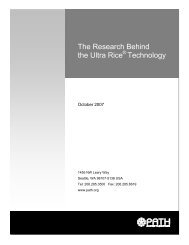Nepal Clean Home Delivery Kit: Evaluation of the Health Impact - Path
Nepal Clean Home Delivery Kit: Evaluation of the Health Impact - Path
Nepal Clean Home Delivery Kit: Evaluation of the Health Impact - Path
Create successful ePaper yourself
Turn your PDF publications into a flip-book with our unique Google optimized e-Paper software.
EXECUTIVE SUMMARY<br />
Tetanus and sepsis are among <strong>the</strong> leading causes <strong>of</strong> maternal and neonatal death and<br />
illness in developing countries. These infections occur mainly as a result <strong>of</strong> contamination<br />
from an unclean environment and from harmful delivery practices, including <strong>the</strong> use <strong>of</strong><br />
unclean materials during <strong>the</strong> delivery. To address <strong>the</strong>se problems, a clean home delivery<br />
kit was developed (with technical assistance from PATH and Save <strong>the</strong> Children U.S. and<br />
funding from USAID, UNICEF, and UNFPA) and has been produced and sold by MCH<br />
Products Pvt., Ltd. since 1994. After more than three years <strong>of</strong> experience and more than<br />
300,000 kits sold, USAID supported PATH under <strong>the</strong> <strong>Health</strong>Tech project to undertake an<br />
evaluation <strong>of</strong> <strong>the</strong> health impact <strong>of</strong> kit use. The study evaluated both short-term health<br />
impacts and intermediate outcomes, such as changes in knowledge or behavior, that<br />
might reasonably be expected to have a beneficial impact on health in <strong>the</strong> long term.<br />
Due to <strong>the</strong> difficulty in detecting significant changes in mortality without very large<br />
sample sizes, <strong>the</strong> study focused on simple cord infection, a more common illness, as a<br />
precursor to more serious infections and an indicator <strong>of</strong> potential exposure to tetanus.<br />
Important intermediate outcomes potentially associated with use <strong>of</strong> clean delivery kits<br />
include behaviors, knowledge, and intentions, such as <strong>the</strong> birth attendant washing her<br />
hands before <strong>the</strong> delivery and <strong>the</strong> cord cutting, correct use <strong>of</strong> <strong>the</strong> items in <strong>the</strong> kit, and safe<br />
reuse or disposal <strong>of</strong> kit items after <strong>the</strong> delivery. Factors potentially related to kit use,<br />
client satisfaction with <strong>the</strong> kit, and reasons for not using <strong>the</strong> kit were also explored.<br />
From July to November 1998, a total <strong>of</strong> 1,660 households in three districts in <strong>the</strong> Terai<br />
(Morang, Siraha, and Sunsari) were contacted 7 to 28 days after <strong>the</strong> birth <strong>of</strong> an infant. All<br />
home births with an infant who survived at least 24 hours after birth were eligible. Six<br />
teams <strong>of</strong> field workers (a male and female on each) located and interviewed <strong>the</strong> new<br />
mo<strong>the</strong>rs and inspected <strong>the</strong> infant’s umbilicus. Mo<strong>the</strong>rs were enrolled in one <strong>of</strong> four<br />
possible cohorts: kit user with trained attendant, kit user with untrained or no attendant,<br />
kit non-user with trained attendant, and kit non-user with untrained or no attendant. A<br />
neonatologist reviewed <strong>the</strong> data from mo<strong>the</strong>rs’ responses to <strong>the</strong> survey (including<br />
selection from among several color photos <strong>of</strong> cord stumps) and <strong>the</strong> field worker’s<br />
observations <strong>of</strong> <strong>the</strong> baby to determine whe<strong>the</strong>r cord infection was likely or not. Multiple<br />
logistic regression was used to determine relative risks and 95% confidence intervals for<br />
infection risk factors and to control for potential confounding factors.<br />
There were several interesting findings with regard to birth practices in this particular<br />
area <strong>of</strong> <strong>Nepal</strong>:<br />
• More than 90% <strong>of</strong> kit non-users (96.7% with trained attendants and 91.6% with<br />
untrained) used a new or boiled blade to cut <strong>the</strong> cord.<br />
• Among trained attendants slightly more kit users washed <strong>the</strong>ir hands before cutting<br />
<strong>the</strong> cord (96% vs. 90%), but among untrained attendants many more kit users than<br />
non-users washed <strong>the</strong>ir hands (91% vs. 76%). <strong>Kit</strong> users were more likely to use soap,<br />
among both trained (96% vs. 73%) and untrained attendants (84% vs. 46%).<br />
1<br />
<strong>Nepal</strong> <strong>Delivery</strong> <strong>Kit</strong> <strong>Evaluation</strong> May 2000
















